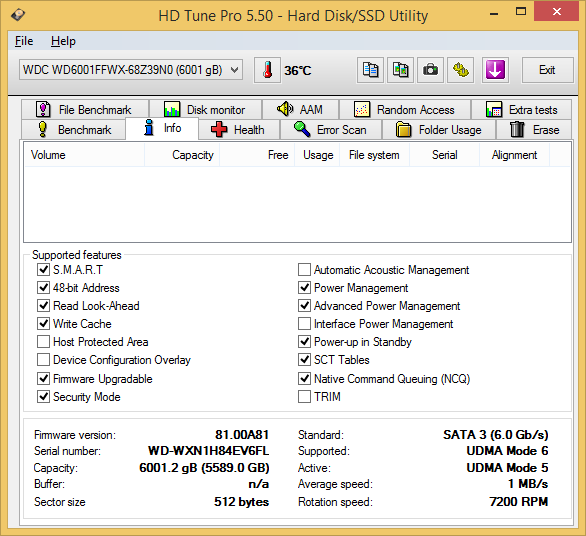WD Red Pro 6 TB Review - High Performance NAS HDD Gets a Capacity Bump
by Ganesh T S on September 7, 2015 8:00 AM EST- Posted in
- NAS
- Storage
- HDDs
- Western Digital
Specifications and Feature Set Comparison
Prior to getting into the performance evaluation, we will take a look at the specifications of the WD Red Pro 6 TB and see how it compares against the other NAS-specific hard drives that we have looked at before.
The WD Red Pro 6 TB sports a SATA III (6 Gbps) interface. As is customary for the high capacity drives in this market segment, it can only emulate 512-byte sectors (natively 4K). The interesting aspect is the presence of a 128 MB cache similar to the Seagate and HGST drives, and unlike the WD Red. The obvious selling point for its price target is the 7200 RPM speed, which should easily give it the lead in most benchmarks over the WD Red. The other aspects (such as the URE ratings, MTBF, warranty etc.) are as expected for a drive targeting SMBs and SMEs. The table below presents the data for the drive against the others in our evaluation database.
| Comparative HDD Specifications | ||
| Aspect | ||
| Model Number | WD6001FFWX | WD6001FFWX |
| Interface | SATA 6 Gbps | SATA 6 Gbps |
| Sector Size / AF | 512E | 512E |
| Rotational Speed | 7200 RPM | 7200 RPM |
| Cache | 128 MB | 128 MB |
| Rated Load / Unload Cycles | 600 K | 600 K |
| Non-Recoverable Read Errors / Bits Read | < 1 in 1014 | < 1 in 1014 |
| MTBF | 1 M | 1 M |
| Rated Workload | ~ 180 TB/yr | ~ 180 TB/yr |
| Operating Temperature Range | 5 to 60 C | 5 to 60 C |
| Acoustics (Seek Average - dBA) | 34 dBA | 34 dBA |
| Physical Parameters | 14.7 x 10.16 x 2.61 cm; 750 g | 14.7 x 10.16 x 2.61 cm; 750 g |
| Warranty | 5 years | 5 years |
| Price (in USD, as-on-date) | $299 | $299 |
A high level overview of the various supported SATA features is provided by HD Tune Pro.

We get a better idea of the supported features using FinalWire's AIDA64 system report. The table below summarizes the extra information generated by AIDA64 (that is not already provided by HD Tune Pro).
| Comparative HDD Features | ||
| Aspect | ||
| DMA Setup Auto-Activate | Supported; Disabled | Supported; Disabled |
| Extended Power Conditions | Supported; Disabled | Supported; Disabled |
| Free-Fall Control | Not Supported | Not Supported |
| General Purpose Logging | Supported; Enabled | Supported; Enabled |
| In-Order Data Delivery | Not Supported | Not Supported |
| NCQ Priority Information | Supported | Supported |
| Phy Event Counters | Supported | Supported |
| Release Interrupt | Not Supported | Not Supported |
| Sense Data Reporting | Not Supported | Not Supported |
| Software Settings Preservation | Supported; Enabled | Supported; Enabled |
| Streaming | Not Supported | Not Supported |
| Tagged Command Queuing | Not Supported | Not Supported |










62 Comments
View All Comments
Souka - Tuesday, September 8, 2015 - link
It would be even louder with four of these WD Red Pro drives!nagi603 - Monday, October 5, 2015 - link
The problem might also lie with your NAS: insufficient decoupling will lead to very nasty vibration, as is insufficient dampening or the use of not stiff enough components.beginner99 - Tuesday, September 8, 2015 - link
Well with the Pro only $33 more it's a no brainer. The 5 years warranty alone will make that a profitable investment alone.Visual - Tuesday, September 8, 2015 - link
Important details are missing from the article. It should be the first thing covered for drives of such capacities - make it clear if they are using a shingled write method requiring rewrites of large blocks for small random writes.Morawka - Tuesday, September 8, 2015 - link
anyone remember when all seagate consumer drives had 5 year warranties.. it was great. now we are lucky to get a 3 year warranty.FunBunny2 - Tuesday, September 8, 2015 - link
planned obsolescence is a wonderful thing. just ask Apple.star-affinity - Tuesday, September 8, 2015 - link
In what way is Apple worse than others when it comes to ”planned obsolescence”?valinor89 - Tuesday, September 8, 2015 - link
As far as I know Apple was the first mass consumer company to embrace the practice. Or at least the best known for it. Usually gadgets of other companyes were expected to be superceeded by advancing technology, not designed to fail after x time... One of the most famous examples was the Ipod Nano case.The practice existed before but apple put it in the spotlight.
Gigaplex - Sunday, September 13, 2015 - link
Apple is rarely the first to do anything. They certainly weren't the first to embrace planned obsolescence.Hannibal80 - Tuesday, September 8, 2015 - link
Why not moving to a 10gbe for the nas test? I think that for a soho scenario could make sense, with a direct 10gb connection between workstation and nas and classic 1gb link among remaining clients. Just my 2 cents